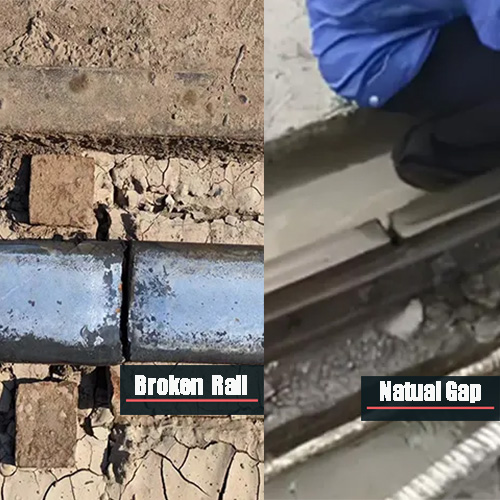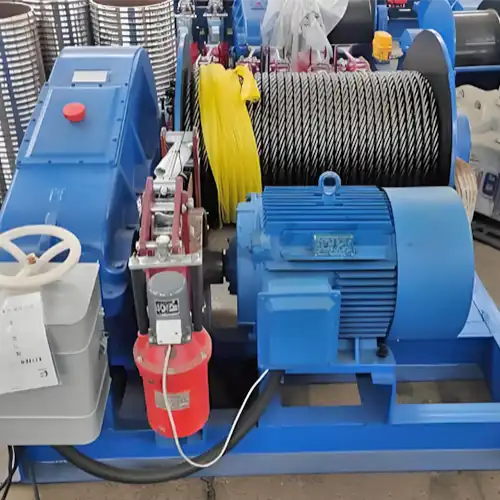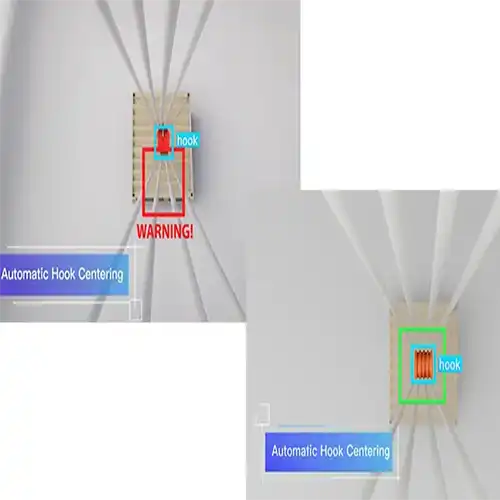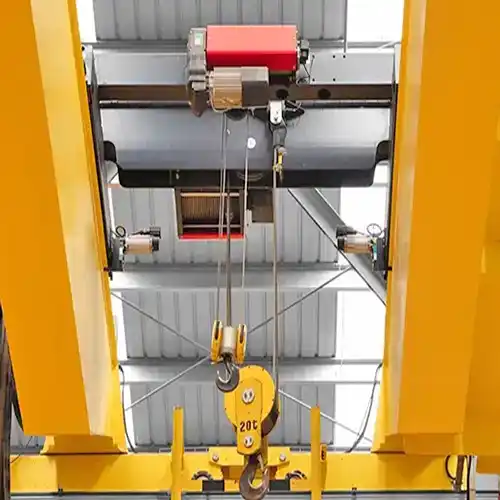Investigating Rail Breakage in Gantry Cranes: Causes & Repairs
Ensuring safe goliath gantry crane operations: Investigate Rail Breakage in Gantry Cranes - Causes, Differentiation from Natural Gaps & Repair Strategies.
Category: Featured
Your Trusted Gantry Crane Manufacturer & Supplier
Investigating Rail Breakage in Gantry Cranes: Causes & Repairs
Ensuring safe goliath gantry crane operations: Investigate Rail Breakage in Gantry Cranes - Causes, Differentiation from Natural Gaps & Repair Strategies.
Overview of Gantry Cranes: Definition and Importance in Shipbuilding Yards
Gantry cranes are large overhead cranes with a hoist that moves horizontally along a rail or pair of rails. These cranes are supported by a structure that allows them to span wide areas. In shipbuilding yards, gantry cranes play a crucial role by lifting and moving heavy components, such as ship sections and machinery. Their ability to handle extremely heavy and bulky materials is essential for shipbuilding tasks. Gantry cranes provide precision placement of ship components, facilitating accurate assembly and construction, which significantly boosts operational efficiency. They are versatile machines used for various tasks, from moving hull sections to installing heavy machinery, making them indispensable in shipbuilding operations.
Rail integrity is vital for the structural support, safety, operational efficiency, and longevity of gantry cranes. The rails support the crane's movement and load-bearing capacity. Ensuring rail integrity maintains the crane's stability and functionality. Intact rails are crucial for safe crane operations, preventing dangerous situations like derailment, load drops, or crane collapse. Proper rail maintenance helps avoid accidents, ensuring the safety of operators and personnel in the vicinity. Smooth and continuous rail integrity ensures uninterrupted crane movement, maintaining efficient material handling and reducing downtime. Regular rail inspections and maintenance extend the lifespan of both the rails and the crane by preventing minor wear and tear from escalating into severe damage.
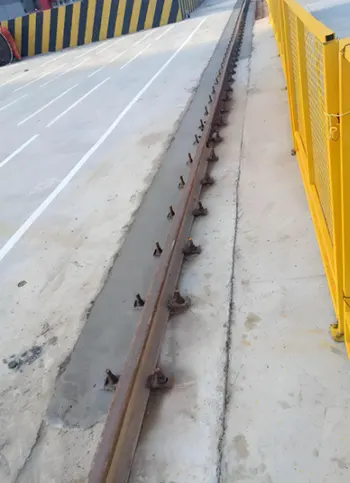
Goliath gantry crane rail
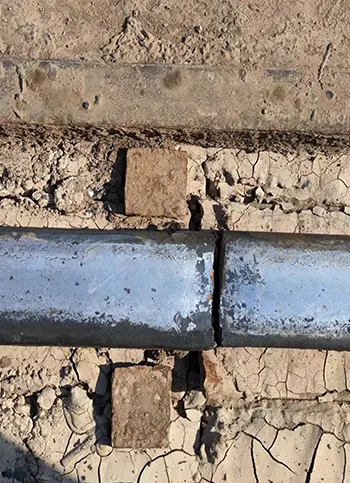
Goliath gantry crane broken rail

Natural gap of crane rail connections
Background
Discuss the Background of Receiving a Consultation from a Client Regarding a Broken Rail in Their Shipyard's Gantry Crane
Recently, a client, a shipyard operator, observed unusual vibrations and misalignment during crane operations. Upon inspection, they discovered a visible break in one of the crane rails. The client expressed concerns about the immediate safety risks associated with the broken rail, including potential derailment or load drops, and the impact on operational efficiency. The broken rail had already caused interruptions in the shipbuilding process. Seeking expert advice, the client reached out for a comprehensive assessment of the broken rail and the overall condition of the crane and its tracks. They wanted to understand the severity of the issue, potential causes, and steps to fix the broken rail. Additionally, they were interested in learning preventive measures to avoid similar issues in the future and ensure the safe and efficient operation of their gantry crane. The consultation aimed to provide a thorough assessment, recommend immediate safety actions, outline the repair process, and develop a long-term plan for regular inspections and preventive maintenance.
This introduction sets the stage for a detailed discussion on managing rail integrity in gantry crane operations, addressing both the technical aspects and the client's specific concerns.
Rail Issues in Gantry Cranes
Why the Question Was Raised
In the shipyard, gantry cranes are vital for efficient and safe operations. When a rail breaks, it raises several immediate and pressing questions. The client's observation of unusual vibrations and misalignment suggested a serious underlying issue. The discovery of a broken rail highlighted potential risks that could not be ignored. Understanding why the rail broke and how to address and prevent such issues is crucial for maintaining safe and efficient crane operations. This question was raised to seek expert insight into the severity of the problem, possible causes, and the best solutions to ensure continued safe and efficient operations.
Client Concerns
The client's primary concerns revolved around safety and operational efficiency: Safety Risks: The broken rail posed immediate safety hazards, including the risk of crane derailment, load drops, and potential injuries to workers.
- Operational Disruptions: The broken rail had already caused interruptions in crane operations, delaying the shipbuilding process and increasing operational costs.
- Long-Term Reliability: The client was concerned about the long-term reliability of their gantry crane system and wanted to ensure that similar issues would not occur in the future.
- Maintenance Practices: They sought advice on improving maintenance practices to prevent rail breakages and ensure the integrity of their crane operations.
Frequency of Rail Breakage
It is not common for gantry crane rails to break under normal operating conditions. However, several factors can increase the likelihood of rail breakage: Material Fatigue: Over time, the constant stress and strain on the rails can lead to material fatigue, making them more prone to breaking.
- Overloading: Exceeding the crane's load capacity can cause excessive stress on the rails, leading to breakage.
- Environmental Factors: Corrosion due to exposure to harsh environmental conditions, such as saltwater in shipyards, can weaken the rails.
- Improper Installation: Poorly installed rails may not provide the necessary support, leading to increased wear and potential breakage.
- Lack of Maintenance: Inadequate maintenance practices can lead to undetected wear and tear, eventually causing the rails to break.
Impact of Broken Rails on Crane Operations
Operational Disruptions
Movement Restrictions and Misalignment: A broken rail can restrict the crane's movement, causing misalignment. This restriction means that the crane cannot move smoothly along its designated path, leading to jerky or halted movements. Misalignment can also cause additional stress on the crane's structure and machinery, potentially leading to further damage and increased wear.
Halts in Production and Increased Operational Costs: When a rail breaks, it often necessitates an immediate halt in crane operations to prevent further damage and ensure safety. This unplanned stoppage disrupts the entire production process, delaying shipbuilding activities. The downtime can result in significant financial losses due to the halted production and the costs associated with emergency repairs and possible replacements. Additionally, the costs of bringing in experts to assess and fix the issue add to the overall expense.
Safety Concerns
- Risks of Crane Derailment and Instability: A broken rail can lead to the crane derailing from its track. Derailment poses a severe safety risk as it can cause the crane to become unstable, leading to a potential collapse. This instability endangers not only the crane but also the surrounding infrastructure and equipment.
- Potential for Load Drops and Swings: The broken rail can cause the crane to lose its stability, increasing the risk of load drops or uncontrolled swinging of the suspended load. Such incidents can damage the load, the crane, and nearby structures. Moreover, they pose a significant risk to the safety of workers in the vicinity, potentially leading to serious injuries or fatalities.
- Danger to Personnel and Equipment: The immediate vicinity of a broken rail becomes a hazardous area. Workers operating the crane or working nearby are at risk of being injured by falling loads, swinging materials, or the crane itself if it becomes unstable. Additionally, the broken rail can cause further damage to the crane and other equipment, leading to expensive repairs and potential replacement of damaged machinery.
Ensuring Safety and Efficiency in Gantry Crane Operations: Managing Rail Integrity
Causes of Rail Breakage
Structural Fatigue
Repeated Stress and Material Fatigue: Over time, the constant use of gantry cranes subjects the rails to repeated stress. This continuous loading and unloading process can lead to material fatigue, where the metal becomes progressively weaker and more brittle. As the metal fatigues, micro-cracks can develop, eventually leading to significant fractures or complete breakage of the rail.
Inadequate Maintenance Practices: Regular maintenance is crucial to detect and address early signs of wear and tear. Inadequate maintenance practices can exacerbate the effects of structural fatigue. Without proper inspections and timely interventions, small issues can escalate into severe problems. Regular lubrication, cleaning, and realignment of the rails are necessary to maintain their integrity and prevent fatigue-related failures. Neglecting these practices increases the likelihood of rail breakage due to undetected and unresolved material fatigue.
Overloading
Exceeding Crane Capacity: Each gantry crane is designed with a specific load capacity. Exceeding this capacity places excessive stress on the rails, which can cause them to bend, warp, or break. Overloading is a significant risk factor because it pushes the crane's structural components beyond their designed limits, leading to premature wear and potential failure.
Effects of Dynamic Loads: Dynamic loads, such as sudden starts, stops, and impacts, can amplify the stress on crane rails. These dynamic forces can cause oscillations and vibrations that further strain the rail structure. Even if the crane operates within its rated capacity, the additional stress from dynamic loading conditions can weaken the rails over time, making them more susceptible to breakage. Proper operational practices and load management are essential to mitigate these effects and protect rail integrity.
Material Defects
- Manufacturing Flaws: In some cases, gantry crane rails may have inherent defects originating from the manufacturing process. These flaws could include inconsistencies in the metal composition, improper heat treatment, or defects introduced during shaping or finishing. Over time, these defects can weaken the rail structure and contribute to premature failure.
- Corrosion: Exposure to harsh environmental conditions, such as saltwater in maritime environments or corrosive chemicals in industrial settings, can lead to corrosion of the crane rails. Corrosion weakens the metal, causing it to degrade and lose structural integrity. Regular inspections and protective measures, such as coatings or galvanization, are essential to mitigate the effects of corrosion and preserve rail integrity.
Improper Installation
- Alignment Issues: Proper alignment of the crane rails is critical for ensuring smooth and safe crane operation. Misalignment, whether due to errors during installation or subsequent shifts in the foundation, can exert uneven stress on the rails, leading to premature wear and potential breakage. Ensuring precise alignment during installation and conducting periodic checks to maintain alignment is essential for preventing rail issues.
- Foundation Problems: The foundation on which the crane rails are installed provides the necessary support for the entire crane structure. Any weaknesses or instability in the foundation can compromise the integrity of the rails. Issues such as settling, shifting soil, or inadequate anchoring can cause the rails to become uneven or unstable, increasing the risk of breakage. Proper foundation design and maintenance are crucial for preventing rail-related problems.
Environmental Factors
- Temperature Variations: Fluctuations in temperature can cause expansion and contraction of the crane rails, leading to stress and potential deformation. Extreme temperatures can also accelerate material fatigue and corrosion, further compromising rail integrity. Proper design considerations, such as expansion joints or thermal insulation, can help mitigate the effects of temperature variations on crane rails.
- Seismic Activity: In regions prone to seismic activity, gantry crane rails may be subjected to additional stress during earthquakes or tremors. Seismic forces can cause the rails to shift or deform, increasing the risk of breakage. Structural reinforcements and seismic-resistant design measures are necessary to ensure the integrity of crane rails in earthquake-prone areas.
Operational Errors
- Operator Mistakes: Inexperienced or improperly trained crane operators may inadvertently subject the crane rails to excessive stress or misuse, leading to accelerated wear and potential damage. Common mistakes include abrupt starts or stops, improper load handling techniques, or exceeding recommended operating parameters. Comprehensive training programs and ongoing supervision are essential for preventing operational errors and preserving rail integrity.
- Accidental Collisions: Collisions between the crane and other objects, such as structures, equipment, or vehicles, can cause significant damage to the crane rails. Impact forces from collisions can deform or fracture the rails, necessitating repairs or replacement. Strict safety protocols, clear operational guidelines, and effective hazard mitigation strategies are essential for minimizing the risk of accidental collisions and protecting rail integrity.
Differentiating Between Broken Rails and Natural Gaps
Visual and Structural Differences
- Appearance and Characteristics: A broken rail typically exhibits visible signs of damage, such as cracks, fractures, or deformations along its length. These abnormalities may be accompanied by misalignment or sagging of the rail profile. In contrast, natural gaps between rails are intentional breaks in the rail alignment, typically characterized by clean, uniform separations between adjacent rail sections.
- Regularity and Purpose of Natural Gaps: Natural gaps between rails are deliberately incorporated into the crane track design to accommodate thermal expansion and contraction of the rails. These gaps allow the rails to expand and contract freely in response to temperature variations, preventing buckling or warping of the track structure. The spacing and placement of natural gaps are carefully planned during the crane track installation to ensure optimal performance and durability under varying environmental conditions.
Impact on Operations
Immediate Hazards vs. Designed Functionality:
A broken rail poses immediate hazards to crane operations, including the risk of derailment, load instability, and potential injury to personnel. It disrupts the crane's intended functionality, leading to operational downtime, production delays, and increased safety risks. In contrast, natural gaps between rails are designed features that serve a specific functional purpose in the crane track system. They facilitate the free movement of the rails, allowing them to expand and contract without compromising track stability or crane performance.
Maintenance and Inspection Protocols
- Regular Inspection and Maintenance: Proper maintenance and inspection protocols are essential for distinguishing between broken rails and natural gaps in gantry crane tracks. Regular visual inspections of the crane tracks are conducted to identify any signs of damage, wear, or structural irregularities. These inspections include close examination of rail joints, welds, and connections to detect any abnormalities or deviations from the expected condition.
- Diagnostic Testing and Analysis: In addition to visual inspections, diagnostic testing methods such as ultrasonic testing, magnetic particle inspection, or acoustic emission monitoring may be employed to assess the integrity of crane rails more comprehensively. These non-destructive testing techniques can detect internal flaws, cracks, or defects that may not be visible to the naked eye, providing valuable insights into the condition of the rails and potential maintenance requirements.
- Preventive Maintenance Measures: Based on the findings of inspections and diagnostic tests, preventive maintenance measures are implemented to address any identified issues and ensure the continued safe and efficient operation of the gantry crane. This may include repairs or replacement of damaged rail sections, realignment of track components, or reinforcement of critical structural elements. By proactively addressing maintenance needs and maintaining rail integrity, the risk of rail breakage and associated operational disruptions can be minimized, enhancing overall crane performance and safety.
Addressing Broken Rails
Immediate Actions
- Ceasing Operations and Securing the Area: Upon discovery of a broken rail, immediate action must be taken to halt crane operations and secure the surrounding area to prevent accidents or further damage. This involves stopping all crane movements, evacuating personnel from the vicinity, and cordoning off the affected area to restrict access.
- Conducting Thorough Inspections and Assessments: Once operations are suspended, a comprehensive inspection of the broken rail and surrounding track infrastructure should be conducted. This inspection includes visual examination of the extent of damage, assessment of potential causes, and evaluation of any associated risks or safety hazards.
Repair Methods
- Removing and Replacing Broken Rail Sections: The damaged rail section must be carefully removed from the track system, taking care to avoid further disruption to adjacent components. Replacement rail sections, of suitable material and dimensions, are then installed to restore the integrity of the track.
- Ensuring Proper Alignment and Secure Installation: During the repair process, meticulous attention must be paid to ensuring the proper alignment and secure installation of the new rail sections. Proper alignment is critical for maintaining smooth crane movement and preventing premature wear or stress on the repaired track.
Quality Control and Testing
- Post-Repair Load Tests and Operational Checks: Following rail replacement, the repaired track undergoes rigorous quality control checks and load tests to verify its structural integrity and operational performance. Load tests simulate crane operations under typical working conditions to ensure that the repaired track can safely support the expected loads and movements.
- Ongoing Inspections and Maintenance: Once the repair process is complete and the crane operations resume, ongoing inspections and maintenance are essential to monitor the condition of the repaired track and prevent recurrence of similar issues. Regular inspections help identify any emerging problems or signs of wear, allowing for timely intervention and maintenance to sustain the long-term reliability and safety of the gantry crane system.
Addressing broken rails promptly and effectively is crucial for minimizing downtime, ensuring the safety of personnel, and maintaining the efficiency of gantry crane operations. By implementing proper repair methods, conducting thorough quality control checks, and establishing proactive maintenance practices, shipyard operators can safeguard against the risks associated with rail breakage and maintain the continuous operation of their gantry crane systems.
Ensuring Safety in Gantry Crane Operations
Regular Maintenance and Inspections
- Scheduled Inspections for Early Detection of Issues: Implementing a routine inspection schedule allows for the early detection of potential issues with gantry crane components, including rails. Regular inspections enable maintenance teams to identify wear, corrosion, or other signs of deterioration before they escalate into more significant problems.
- Lubrication and Cleaning to Reduce Wear: Proper lubrication of crane components, including rail joints and wheels, helps reduce friction and wear, prolonging the lifespan of the equipment. Additionally, regular cleaning removes debris and contaminants that can contribute to accelerated wear and corrosion, ensuring smooth crane operation.
Operational Best Practices
- Adhering to Load Capacity Limits: Operating gantry cranes within their designated load capacity limits is essential for preventing overloading and excessive stress on the rails and other structural components. Strict adherence to load limits helps maintain crane stability and prevents premature wear or damage to the equipment.
- Training Operators in Safe Practices and Emergency Procedures: Providing comprehensive training to crane operators on safe operating practices and emergency procedures is critical for ensuring the safety of personnel and equipment. Operators should be familiar with proper load handling techniques, crane controls, and emergency shutdown procedures to minimize the risk of accidents or injuries.
Environmental and Structural Controls
- Corrosion Protection and Thermal Stress Management: Implementing corrosion protection measures, such as coatings or galvanization, helps safeguard crane components, including rails, from the corrosive effects of environmental exposure, particularly in maritime or industrial environments. Additionally, managing thermal stress through proper insulation or expansion joint design reduces the risk of rail buckling or warping due to temperature fluctuations.
- Immediate Inspections Following Unusual Events: Following unusual events such as severe weather, seismic activity, or accidental collisions, immediate inspections of gantry crane components, including rails, should be conducted to assess for any potential damage or structural weaknesses. Prompt identification and mitigation of issues help prevent further damage and ensure continued safe operation of the crane.
Emergency Protocols
- Safety Drills and Emergency Response Plans: Regular safety drills and the development of comprehensive emergency response plans are essential for preparing personnel to respond effectively to potential crane-related emergencies. These drills should include simulations of various emergency scenarios, such as crane malfunctions, load drops, or personnel injuries, to ensure that employees are adequately trained to handle such situations.
- By prioritizing regular maintenance and inspections, adhering to operational best practices, implementing environmental and structural controls, and establishing robust emergency protocols, shipyard operators can mitigate risks and ensure the safety of gantry crane operations. These proactive measures help minimize downtime, prevent accidents, and maintain the efficiency and reliability of gantry crane systems.
Is It Normal to See Broken Rails in Gantry Cranes?
Frequency in Different Environments: The frequency of broken rails in gantry cranes can vary depending on the operating environment. In shipbuilding yards, where gantry cranes are subjected to heavy loads and harsh maritime conditions, broken rails may occur more frequently compared to other settings. Factors such as exposure to saltwater, dynamic loading from moving heavy ship components, and constant use contribute to the increased risk of rail breakage in shipbuilding yards.
Risk Factors: Several conditions can increase the likelihood of rail breakage in gantry cranes. These include overloading beyond the crane's capacity, inadequate maintenance practices, environmental factors such as corrosion or temperature fluctuations, structural defects, and operational errors. Identifying and addressing these risk factors is crucial for minimizing the occurrence of rail breakage and ensuring the safety and reliability of gantry crane operations.
Comparison with Industry Norms: While broken rails are not considered normal occurrences in gantry cranes, they are recognized as potential risks that require proactive management. Across the industry, gantry crane operators adhere to strict maintenance and inspection protocols to prevent rail breakage and ensure safe operations. Comparisons with industry norms can help assess the prevalence of rail breakage and identify areas for improvement in maintenance practices and risk mitigation strategies.
Conclusion
Summary of Key Take-away:
- Importance of Rail Integrity for Safe and Efficient Crane Operations: - Rail integrity is crucial for the safe and efficient operation of gantry cranes in shipbuilding yards. Maintaining rail integrity ensures smooth crane movement, prevents accidents, and minimizes downtime, thereby optimizing productivity and safety.
- Differentiation Between Broken Rails and Natural Gaps: - Distinguishing between broken rails and natural gaps is essential for effective maintenance and safety management. While broken rails pose immediate hazards and require prompt attention, natural gaps are intentional features designed to accommodate thermal expansion and contraction of the rails.
- Comprehensive Approach to Inspection, Maintenance, and Safety: - Implementing a comprehensive approach to inspection, maintenance, and safety is essential for managing rail integrity in gantry crane operations. This includes regular inspections, proactive maintenance practices, adherence to operational best practices, and robust emergency protocols to ensure the continued reliability and safety of crane operations.
- Emphasis on Proactive Measures to Prevent Rail Issues: - Proactive measures are key to preventing rail issues and maintaining the integrity of gantry crane operations. By implementing regular inspections, adhering to maintenance schedules, and providing continuous training to operators, gantry crane operators can identify potential problems early and take corrective action to prevent accidents and optimize performance.
- The Role of Continuous Training and Adherence to Best Practices: - Continuous training and adherence to best practices are essential for ensuring the safety and efficiency of gantry crane operations. Well-trained operators who follow established protocols can mitigate risks, respond effectively to emergencies, and contribute to a culture of safety and excellence in crane operations.
By emphasizing the importance of rail integrity, differentiation between rail issues, and the implementation of proactive measures, gantry crane operators can ensure safe and efficient operations, minimize downtime, and optimize productivity in shipbuilding yards.
Related Products

Latest project
150 Ton Overhead Crane Installation Feedback – Paraguay Case
QDX 150 ton overhead crane in action in Paraguay. Installation photos, video, and client feedback show performance, safety, and heavy-lifting efficiency.
Free consultation to Confirm Parameters & Specifications and Get
Latest Crane Price & Crane Rate.
- Types of overhead cranes : _______?
- Optional: Overhead travelling crane, goliath gantry crane,Slewing jib crane, Single girder or double girder crane,small portable crane or kbk crane, etc.
- Capacity of overhead crane: _______?
- Optional: 0.25ton, 0.5 ton, 1 ton, 2 ton, 3ton, 5 ton, 10 ton,15ton, 20ton, 25 ton, 30ton,35ton, up to 550ton, etc.
- Crane span & lifting height : _______?
- Crane travelling length : _____?
- Control of overhead crane:_______?
- Optional: pendant/ remote/cabin control
- Voltage supply of overhead crane:_____?
- Eg,: 380V50/60HZ,3Phase or others,etc.
- Application/usage of crane:_______?
- Eg,: Steel mill, ,injection mold, cement,stone, concrete,granite, general manufacturing, etc.
Just leave a message via the contact form and our hoist and crane engineer will contact you with in 24working hours.
Get In Touch
